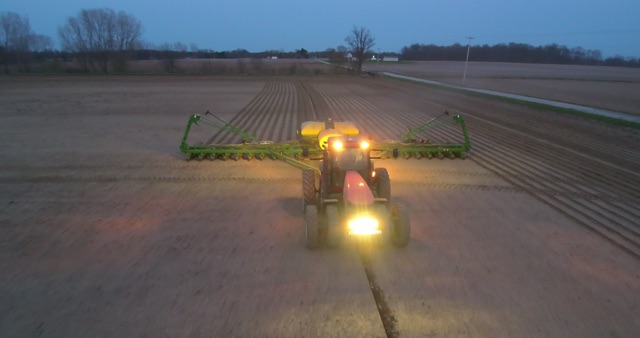Farmers must make decisions and take action at various points throughout the year to ensure a good harvest. National Corn Growers Association Corn Board member and Ohio corn farmer John Lindner talks about getting ready for spring planting.
Soil testing
Soil sampling gives us an idea about the nutrient levels on our fields, to help us understand our fertilizer needs and to assess whether our previous fertilizer applications were effective. Based on this information, we can make changes to our fertilizer applications and increase our operation’s efficiency. Soil sampling, done every 3-4 years on a given field, is a key component to being a good steward of the land.

We test for all of the essential macronutrients (Nitrogen, Phosphorous, Potassium, Calcium, Magnesium), as well as pH, buffer pH, organic matter, Cation Exchange Capacity (CEC), base saturation of cations (Calcium, Potassium, and Magnesium) and sometimes micronutrients (Boron, Sulfur, Copper, Iron, Zinc, and Manganese). pH and CEC are important soil measurements because they affect which nutrients are available and how much the soil can hold.
We hire a private crop consultant that has an expertise in soils. He samples our soil based on soil type—we have also employed some grid soil sampling on our farm. Based on the analysis and his advice, we can create variable rate fertilizer prescriptions. This technology helps to specify the amount of fertilizer needed and where it is applied. This prevents the overapplication of fertilizer and helps us be better stewards of the land. It also typically means that we purchase less fertilizer than we would with a straight rate of fertilizer, which helps our bottom line.
To supplement nutrient deficiencies, we apply fertilizer such as potash (0-0-60) for a potassium deficiency, lime (calcium carbonate) for a low pH, monammonium phosphate (MAP) for a phosphorous deficiency). There are also other forms of fertilizer, such as manure, that we can apply.
Your students can do their own soil assessments using these Feed the World lessons:
No-till
Being “no-till” means that we don’t do any tillage to the soil. This changes the soil in several ways that can affect planting.
- First, no-till soil generally takes longer in the spring to reach planting-friendly temperatures, which can delay planting a little bit.
- No-till soils can also have less soil compaction, which can improve plant emergence.
- Organic matter also increases over many years of no-tilling, which is known to have many benefits.
- Carbon sequestration and water retention are benefits of no-till systems as well.
The no-till system improves soil structure and decreases soil loss. Lower levels of compaction improve soil structure. Increasing water infiltration leads to less soil loss due to erosion because the water moves down through the soil profile rather than across it.
Crops do better in no-till during dry weather conditions because of the increase in soil water infiltration (water can reach the crop’s root zone for absorption) as well as the increased water holding capacity (the soil holds more water).
Weeds
Our crop consultant regularly scouts our fields for weeds before and during the season. A burndown (before planting) or pre-emergence (after planting, but before plant emergence) application of herbicides can be applied to address any weed issues and keep the crop weed-free during the critical weed-free period (4-6 weeks into the planting season). This period exists to prevent competition with weeds while the crop is trying to get established. A good herbicide program is one that abides by label rules, uses several modes of action to prevent the development of weed resistance, and includes the recommended additives to ensure that the herbicide works as it is supposed to.
Preparing for corn planting
We do seasonal maintenance on power units such as tractors, put the planters through an extensive pre-season checklist, and perform calibrations. We ensure that we have planned our inputs, such as seed and fertilizer.
“A corn crop requires a variant of nutrients. Without nitrogen, corn plants cannot grow and photosynthesize adequately. Phosphorous and potassium are also very important.”
Nutrients
A corn crop requires a variant of nutrients. Nitrogen is incredibly essential. Without it, corn plants cannot grow and photosynthesize adequately. Phosphorous and potassium are also very important—phosphorous affects crop health and vigor, and potassium enhances photosynthesis and plant food production. These are the main nutrients for corn production, but pH, which affects nutrient availability, and other macro- and micronutrients also play important functions in crop development. A balanced soil nutrient approach is always best because we rotate our crops, and different crops have different nutritional requirements.
Between the different growth stages in corn—from vegetative growth to reproductive growth—there are different nutritional requirements for growth. For example, most nitrogen uptake happens during the reproductive (R1-R6) stages of growth).
One of the most common ways to apply nutrients is through surface broadcast followed by some type of incorporation (tillage) to get it into the soil and prevent loss. We tend to use subsurface banding applications that can be applied using the planter or another method. Nitrogen is typically banded before or right after planting. We usually apply our subsurface nitrogen after planting using 28-0-0 in a side-dress application. Banding places the nutrient below the soil surface – eliminating the need for incorporation.
We’ll feature other updates on corn planting through the year in upcoming newsletters!